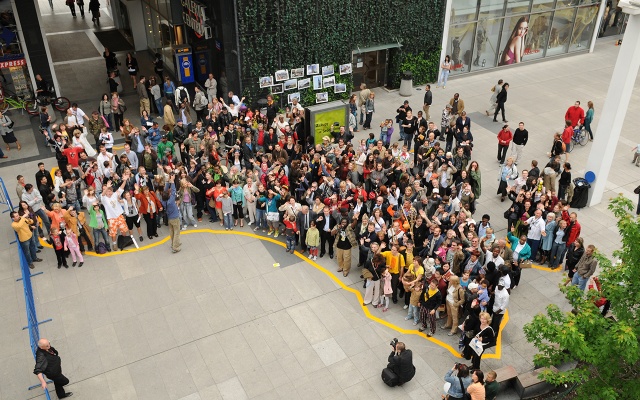The African community in Poland is small, with no more than a symbolic public presence, albeit this has changed somewhat over the last decade. How the African diaspora is perceived depends as much on the image of Africa and its population across the Polish media as on how active individual Africans are in Polish cultural life, politics, and sport and the exposure their activities receive.
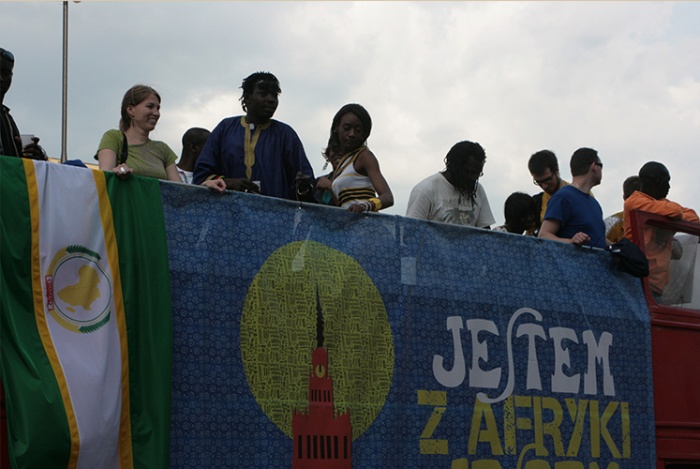
(c) archiwum Fundacji "Afryka Inaczej"
The statistics are merciless. One would look in vain for immigrants from so-called “sub-Saharan Africa” (to borrow a term still used by the UN, but now deemed by some vague, divisive, and a vestige of post-colonialism) anywhere near the top of the list of Poland’s foreign residents. It is only in position 51 that we find Nigeria (the continent’s most populous country) with 816 residents; in the first hundred countries, we find 273 people from the RSA, 252 from Zimbabwe, 212 from Cameroon, 161 from Kenya, 151 from the Congo, 120 from Angola, 113 from Rwanda, 102 from Ghana, and 84 from Ethiopia.1 Not all of these nationals of different African countries have settled in Poland permanently; many are just temporary residents, students for example. Often, Poland is a destination of necessity rather than choice. Interestingly, African nationals in Poland are predominantly male.
The limited volume of African migration to Poland is in part due to the country’s lack of any colonial past. Poland has not harbored any great aspirations to colonial conquest, and indeed for 123 years, it had itself been subjugated by three foreign invaders.2 Oppression by foreign powers could thus be presented as a shared experience, but this is not the prevailing perception. The fact that wages in Poland are not in the same league as those in the affluent European countries, is another reason why the country is considered a temporary destination by migrants.
Stadium Africa
The character of migration to Poland has been changing. In the communist era – with the first wave of noticeable African migration, encouraged by socialist countries’ aid to African countries that were in the process of shedding their colonialist yoke and building a support network – the migrants were prevailingly students. Following the fall of the Iron Curtain, athletes, and economic immigrants began to arrive from the African continent.
They were portrayed by the Nigerian writer Ify Nwamana, who in his novel Stadium: The Devil’s Playground (2009) described the Nigerian community in Warsaw that was engaged in trading in the open-air market set up in the Tenth-Anniversary Stadium. The chief protagonist, Mike, who had entered the country thanks to a fake invitation from a sports club, was engaged in trading fake documents, seeking other ways of earning a living, when news spread of the impending closure of the stadium.3 The publication got Nwamana in trouble with circles connected to the stadium, because he showed Africans as people who sailed close to the wind as far as the law was concerned in order to make a living in harsh conditions.

(c) archiwum Fundacji "Afryka Inaczej".
At the other end of the spectrum is another novel by a Nigerian author, which did not, however, have the same impact. In his book Black Factor, Iyke Nnaka’s focused on Africans who were victims of racist prejudice rather than, as Nwamana did, painting a negative picture of his own community. Here, the plot revolves around protagonists victimized by an organized racist group and falsely accused of committing a crime, followed by a happy ending, when they are acquitted.4
What both books have in common is that they both stemmed from the author’s desire to talk about their own community and deal with the reality of living in Poland. The authors in no way intended to justify their presence in the European country; they simply depicted radically different perceptions of that phenomenon. For Nwamana, the “book about the stadium is proof that he has grown roots in Poland.” And, although he is tired of Poles asking “why he described only bad Africans,” he patiently explains that those from his continent are not all like that, and that it is absurd to accuse him of consolidating the stereotype of the “bad immigrant.” Nwamana realizes that he will continue having to justify himself, as much as keep having to face another recurrent question: why had he come to Poland?” 5
Africa Divided
Contrary to the possibly naïve preconceptions of outsiders, skin color alone is not enough to unite the African diaspora in Poland; it is a constellation of micro-communities. What matters is language: some groups are francophone, others English- or Portuguese-speaking. And immigrants from a given country stick together, be they Nigerians or Senegalese.
Africa is a far from homogenous continent, encompassing as it does a multitude of cultures, traditions, and languages. Indeed, the countries of the Maghreb or Arab-speaking North Africa, promote an identity distinct from that of the rest of the continent, identifying themselves as Mediterranean rather than African, with an acute awareness of their shared Arabic heritage.
When working on my first book about the history of Africans in Poland I was challenged on whether it was legitimate to call a community of people from different parts of Africa a “diaspora,” and whether it would not be more legitimate to talk about a Senegalese or Nigerian diaspora. To my mind, in the Polish context, the general term is justified by the relatively small numbers of Africans living in the country, bearing also in mind that the term does not include immigrants from the Maghreb, in order to acknowledge their separate sense of identity.
Such an approach does have its drawbacks when constructing a common African identity; the political manifesto of Pan-Africanism does not faithfully reflect African reality – the continent is a jigsaw puzzle of often incompatible elements, which should hardly surprise Europeans, since the history of our own continent reflects a similar reality.
Folksy Africa
Poles asked what springs to their mind in relation to African music, immediately reply, “drums.” A number of polls commissioned by the "Africa Another Way" Foundation shows that, in the general perception, African art is assumed to be folk art, the continent pickled in folkloric aspic as in a time capsule. In our questionnaire conducted in 2010, our respondents associated African culture with dancing round a bonfire with spears, or making wooden figurines, rather than with books or films.6 Similar perceptions still prevailed in a poll conducted four years later, and the respondents also referred to attachment to tradition and a lifestyle untarnished by the failings of Western civilization7 – in comments reminiscent of those to be found in the diaries of the missionaries and explorers who travelled in Africa some two hundred years ago.
Simon Njami, the well-known art critic, who curated the series of exhibitions Africa Remix maintains that there is no such thing as African art. “Art is a universal concept. […] Polish art? African art? These are no more than adjectives, rigidly applied from the dictionary. A play on words and concepts.” To illustrate his point, Njami mentions the fact that the first European colonizers of Africa came to the conclusion that the natives had no history – because they had kept no records of their past. In the perception of fifteenth-century explorers, no world could be said to exist unless it was archived. For Africans, whose identity had historically relied on oral tradition, it was Europeans, who scribbled things down, that seemed peculiar.8
Off the Radar: A Far-Away Land, People of Whom We Know Nothing
We leave school with little information on Africa, but our ignorance stems also from how the continent is presented in the media. Firstly, Africa is far away, thus – unsurprisingly – off our radar, our attention diminishing in direct ratio to the mileage that separates us from the region in question. This principle works in both directions – someone living in Lagos is not interested in what is going on in Warsaw. The only exceptions are spectacular catastrophes, political coups, and genocide with plenty of fatalities, especially if counted in their thousands. It is on such occasions that Poles find out about the country called Rwanda, where the Tutsi and Hutu live.
In a nutshell, the Polish media and their audiences are focused primarily on the here-and-now; the best African ambassadors in Poland are those natives of that continent who now themselves live between the Oder and the Bug, with a leading role played by media people, footballers and politicians – the latter especially. In the Sejm, which is the lower house of the Polish parliament, there are two African members: John Godson and Kilion Mynyama. As Mamadou Diouf has pointed out, “The fact that two Africans have taken their seats in the [Polish] parliament, is a phenomenon on a global scale, even when taking into account countries such as Britain or France, where if someone African is a member of parliament this is thanks to the support of the comparatively sizeable African diaspora. Where the situation in Poland is unique is that the local electorate voted for two people who were born on the African continent. Someone may perhaps consider this a mere triviality, but I think that this is something that really does matter a lot.”9
Sportsmen are less likely to make front-page headlines. It is not easy to find a worthy replacement for Emmanuel Olisadebe, who played in the Polish national team. Even Olisadebe had to put up with unpleasant incidents such as Polish fans throwing bananas at him. Things are different for the media people. The arrival of the TV presenters Patrycja Kazadi and Omena Menshah was a significant development. They both have had a chance to present Africa, the continent of the fathers of both celebrities. Mensah even managed to set up her own foundation that has sponsored a school in Ghana, the country that her father comes from. She has also written an autobiography with the eloquent title Bitter Chocolate.10
In the last few years another African, Father John Bashobora from Uganda, regarded as a healer, has hit the tabloid headlines, becoming a household name in Poland, drawing thousands of self-declared religious followers to his events organized in large sports arenas. His presence did away with the barriers that separated Poland and Africa. Journalists note that the Father Bashobora phenomenon is a specific phenomenon of Polish society.11 Africa, seemingly distant and wild, is, after all, not as culturally remote as some Poles imagine, if one takes the religious aspect into account.
Africa of Missionaries and Humanitarian Aid
For more than a century it was the Catholic Church and its missionaries that were the main source of information about Africa. Returning to parishes in Poland, they highlighted the hardship of the missionaries’ work and appealed for support for their evangelical effort in Africa. This was only a partial image of the African continent. Today, this trend seems to have been reversed in Europe. It is the citizens of countries once targeted by missionaries that now perform religious services in European parishes and churches, including Polish ones.
Another sector that affects how Africa is presented is humanitarian aid, campaigns to raise funds to heal Africa’s many woes. One memorable example is the water project for digging wells; in consequence, and unsurprisingly, respondents mention lack of water as one of the main factors they associate with the continent. The NGOs do not bother to provide the general information that this is a localized, regional problem in Africa.12
Such is the image that members of the African diaspora in Poland have to cope with. The perception is that they are “savage” and “recently baptized,” that they murder one another and spread infectious diseases. Many Poles see them as uncultured, or having a culture that is, at best, primitive. Polish culture is thus “superior.” Such thinking, which could be termed cultural racism, continues to be present in Polish perceptions. It is futile to hope that anyone may have heard of any Nobel Prize winners from Africa. Only occasionally will a respondent mention Nelson Mandela, and then usually only by the surname.13
Dispersed
The African community in Poland is still in a state of flux. Africans do not create their own districts or residential areas, tending to live amongst Poles. This is a factor in making possible a specific model of integration. Much depends on the individuals and how resilient they are when faced with difficult situations of the kind that people of different skin color still encounter in Poland. Moreover, some of the African immigrants do not learn Polish, perhaps because they see their stay as temporary. It is crucial that one can speak the language of the community in which one lives, as Mamadou Diouf points out. But the migrants are not all prospective students; some are people who are illiterate, and it is that group that is prone to ghettoization and living in a cultural underground.
Nevertheless, the migrants in Poland are dispersed, and the phenomenon of African immigration is not as visible as it is in the affluent European countries, which provides an opportunity for creating an African diaspora. Another phenomenon worth noting is the appearance of a new identity, which one might call Afro-Polish. Mamadou Diouf is an example thereof par excellence. He is a musician that plays with well-known groups, a radio journalist and a cultural animator. As he emphasizes himself, culturally he feels a Pole. He came to know the country in which he has spent most of his life by learning its customs and history. This, however, does not mean that he has dissolved in Polishness as sugar in a cup of tea. He feels he is a part of Polish society, without forgetting his Senegalese roots. Diouf’s dual identities that function in parallel have made him one of the most active ambassadors for the African diaspora in Poland.
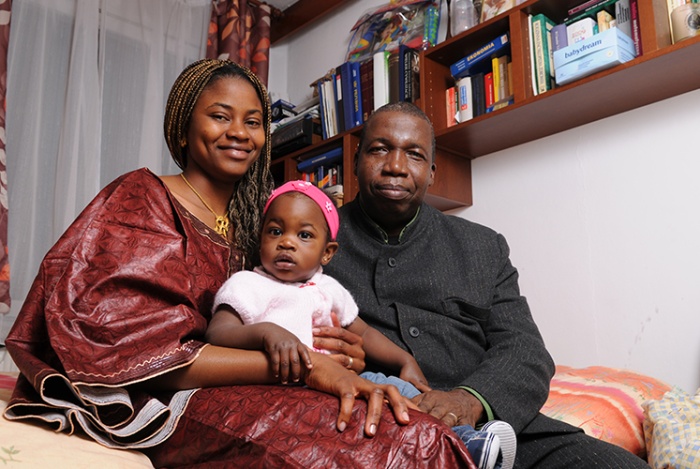
(c) archiwum Fundacji "Afryka Inaczej"
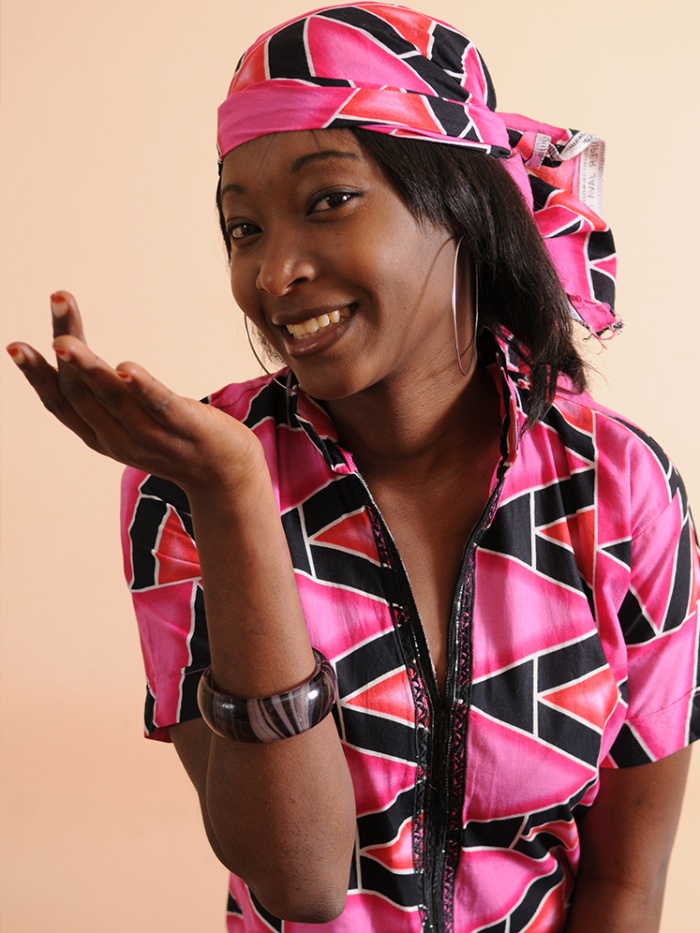
(c) archiwum Fundacji "Afryka Inaczej"
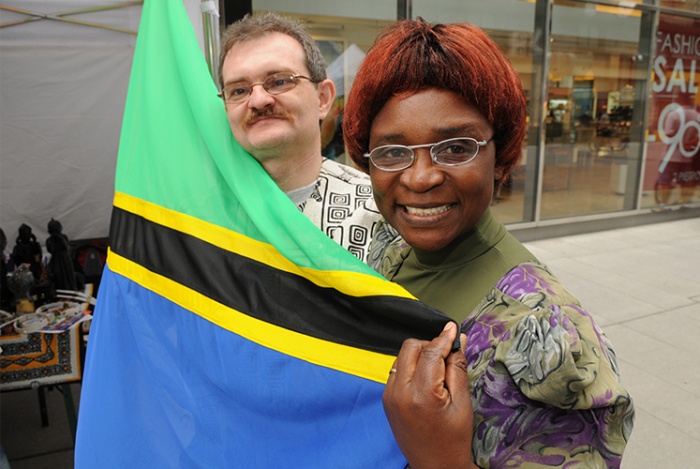
(c) archiwum Fundacji "Afryka Inaczej"
Poland, We Live Here
Africans attempt to show their presence through books, as well as musical and cultural activity. They also seek to establish intercultural dialogue. One such project was that of Sylwester Kozer from the Czerniakowska Band. Senegalese musicians Mamadou Dioufa and Pako Sarra and the Vilnius Band joined forces to play together. The result was a joint concert in Vilnius and the making of a recording of the song Mama Africa and Mother Lithuania. This musical get-together allowed Poles from the Vilnius region, living in conditions not conducive to identity displays, to meet Africans, who, in turn, had the opportunity to learn about the problems of the Polish minority in Lithuania. Such organic situations are one of the best opportunities for dialogue and the improvement of mutual knowledge.
The African diaspora does, however, have many faces. It comprises many very different individuals – some are students and career people, others come to Poland with no financial resources and soon join the legal twilight zone. I have experienced this myself. Some years ago, I was contacted by Polish border customs officers. A group of people was trying to enter Poland with a fake invitation that they had manufactured, complete apparently with a forgery of my signature. Groups are often judged on the basis of individual behavior, as the German myth about Polish car thieves proves. The entire migrant community is tarred with the same brush for the sins of any one of them. The question is how mature and understanding the society that receives the migrants turns out to be.
The African community is small and there is nothing to suggest that we are facing a rapid influx of people of African origin. This is not due to the actions of the Polish authorities, but to Poland’s limited appeal to migrants and its geographical location. Much will depend on the reaction of the host country. Valuable initiatives are undertaken, also by Poles, to look for traces of people of African descent. This was how Agboola Brown, a Nigerian participant in the Warsaw Uprising, was discovered and saved from oblivion,14 as was Mokpopko Dravi, who played Jumbo in the film Cafe pod Minogą,15 and it was possible to commemorate Sam Sandi, who fought in the Polish-Bolshevik war, and settled in Wielkopolska.16 Today, black people are not a surprising sight in the streets of big Polish cities. Nevertheless, Africans continue to be visibly invisible.
Translated from Polish by Anda MacBride
BIO
Paweł Średziński – Doctor of Humanities, historian by education, journalist, and political scientist. For many years, in his research he has focused on issues related to Africa and ecology. The winner of Gazeta Wyborcza’s Stołek Roku prize. Author of various publications on Africa. Co-founder of Afryka.org and the „Afryka Inaczej” Foundation. An alumnus of the U.S. Department of State's International Visitor Leadership Program (IVLP). Regular contributor to Nowa Konfederacja and editor of Afryka.org. He has also been a contributor to Więź, Gazeta Wyborcza, and OKO.PRESS.
* Cover photo: from the archive of Foundation "Africa Another Way".
[1] Statistics on migrants in Poland, data for 2019, https://migracje.gov.pl/statystyki/zakres/polska/typ/dokumenty/widok/tabele/rok/2019/, [accessed: 1 December 2019].
[2] Paweł Średziński, Polska też była kolonią, in: Czy Afryka jest krajem?, Warszawa 2011, pp. 39–42.
[3] Ify Nwamana, Stadion. Diabelskie igrzyska, Warszawa 2009.
[4] Iyke Nnaka, Black Factor, Częstochowa 2010.
[5] Nie jestem złym Mikiem, Gazeta Wyborcza, 6 May 2009, https://wyborcza.pl/1,76842,6575779,Nie_jestem_zlym_Mikiem.html, [accessed: 1 December 2019].
[6] Badanie opinii publicznej na rzecz integracji obywateli państw afrykańskich w Polsce, Warszawa 2010, pp. 11–12.
[7] Badanie opinii publicznej na temat integracji obywateli państw afrykańskich w Polsce, Warszawa 2015, pp. 24.
[8] Paweł Średziński, Czy istnieje sztuka afrykańska?, afryka.org, 24 February 2006, http://afryka.org/czy-istnieje-sztuka-afrykanska/, [accessed: 1 December 2019].
[9] Kulturowo jestem Polakiem. Wywiad z Mamadou Dioufem, Nowa Konfederacja, 8 May 2019, https://nowakonfederacja.pl/kulturowo-jestem-polakiem/, [accessed: 1 December 2019].
[10] Paweł Średziński, Afryka i jej mieszkańcy w polskich mediach. Raport z monitoringu polskich mediów, Warszawa 2016, pp. 9–14.
[11] Paweł Średziński, Afryka i jej…, ibidem, pp. 21–22.
[12] Paweł Średziński, Afryka i jej..., ibidem, Warszawa 2011, pp. 12–14.
[13] Badanie opinii publicznej…, op. cit., pp. 11–13.
[14] Afryka w Warszawie. Dzieje afrykańskiej diaspory nad Wisłą, Warszawa 2010.
[15] Paweł Średziński, Mokpokpo Dravi – historia prawdziwa, Warszawa 2015.
[16] leksander Przybylski, Sam nie taki sam, Afryka.org, 27 June 2018, http://afryka.org/sam-nie-taki-sam/, [access: 1 December 2019].



